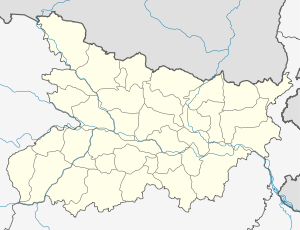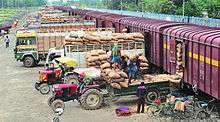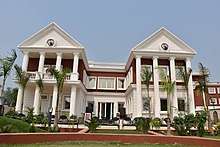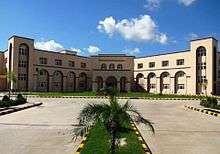Purnia
| Purnea | |
|---|---|
| Urban Agglomeration | |
| Nickname(s): Mithila ki Nagari,[1] Mini Darjeeling,[2] Jute City | |
 Purnea Location in Bihar, India | |
| Coordinates: 25°47′N 87°28′E / 25.78°N 87.47°ECoordinates: 25°47′N 87°28′E / 25.78°N 87.47°E | |
| Country |
|
| State | Bihar |
| Region | Mithila (Seemanchal subregion) |
| District | Purnia |
| Government | |
| • Type | Municipal Corporation |
| • Body | Purnea Municipal Corporation |
| • Mayor | Smt Savita Devi |
| • MP | Santosh Kushwaha |
| • MLA | Mr. Vijay khemka |
| Elevation | 36 m (118 ft) |
| Population (2011)[3] | 310,817 |
| • Rank | 5th in Bihar |
| • Municipal | 282,248 |
| Time zone | UTC+5:30 (IST) |
| PIN | 854301,02,03,04,05,26 |
| Telephone code | +91 6454 |
| Vehicle registration | BR-11 |
| Literacy | 74.09% |
| Lok Sabha constituency | Purnia |
| Website |
purnea |
Purnia (also romanized as Purnea (Official); Devanagari : पूर्णियाँ ) is a city that serves as the administrative headquarters of both Purnia district and Purnia division in the Indian state of Bihar. It is the largest city in northeastern Bihar also known as Kosi- Seemanchal area. Total geographical area of Purnia municipal corporation is 92 km sq.[4] which is next only to Patna. Population density of the city is 3058 persons per km sq. making it the 5th largest city of Bihar. It is nearly 302 kilometres from Patna,the shortest route of purnia is 302 km and the longest route is 366 km from patna, the capital of Bihar, as well as 171 km from Siliguri, 90 km from Bhagalpur.It is 640 km from Guwahati (Approx.) and 450 km from Kolkata , the capital of the adjacent state of West Bengal and the largest city in East India. Purnia district covers 3202.31 sq. km of the state of Bihar. The Indian Army, Indian Air Force, and three of five branches of India's Central Armed Police Forces – the Border Security Force (BSF), the Sashastra Seema Bal (SSB), and the Indo-Tibetan Border Police (ITBP) – have bases around the district.
Etymology
Several possible origins for the name Purnia have been proposed. The name may originate from the Sanskrit word Purna–Aranya, which means "complete jungle".[5] Purnia could also be an altered form of the old name Purania, derived from the word purain or Lotus, which is said to have grown on the Kosi and Mahananda rivers. This derivation is stated by O'Malley and is also in the old gazetteer. Another alternative derivation is from the words Purn Aranya. W.W. Hunter and Buchanan have mentioned the name of Purnia, it being a forested area, using a combination of the words purn (full) and aranya (forest). In 2007 Purnia DM Mr Ramweshar formed a group to find, Purnea district records .Team member past due Sankar dy investigated British authorities information then he changed into concluded as, Purnea district became fashioned in 14 February 1770 before Bihar Bangal department. Each year, 14 February is celebrated in memory of the city's origin.
The city's name is also romanized as Purnea.
History
Purnia is part of the Mithila region.[6] Mithila first gained prominence after being settled by Indo-Aryan peoples who established the Mithila Kingdom (also called Kingdom of the Videhas).[7] During the late Vedic period (c. 1100–500 BCE), Videha became one of the major political and cultural centers of South Asia, along with Kuru and Pañcāla. The kings of the Videha Kingdom were called Janakas.[8] The Videha Kingdom was later incorporated into the Vajji confederacy, which had its capital in the city of Vaishali, which is also in Mithila.[9]
Geography
Purnia and its surrounding lands lie in the sub-montane alluvial tract of the Gangetic Plain. The city however lies on the banks of numerous tributaries of the Koshi River.
Purnia has an area of 3,202 square kilometres (1,236 sq mi). This leveled depressed tract of country consists for the most part of a rich, loamy soil of alluvial formation and is traversed by several rivers flowing from the Himalayas, which afford great advantages of irrigation and water-carriage. Its major rivers are the Kosi, the Mahananda, the Suwara Kali and the Koli. In the west the soil is thickly covered with sand deposited by changes in the course of the Kosi. Among other rivers are the Mahananda and the Panar. Its major agricultural products are jute and banana.
There is a hilly tract in the north with a small hill of Calcareous belt, called Chotapahar near Manihari. It has a slope from the north to the south and is traversed by a number of rivers and their tributaries. The district is composed of alluvial soil, partly old and partly new. The old alluvium is found in the north of the district where it consists of kankars (stone dust). The new alluvium is available in the south of the district and is composed of silt, clay and sand. The alluvial soil is supposed to be brought by the Ganges and its tributaries from the Himalayas and is very rich in fertilizing nutrients.
Climate
Purnia is known for its favourable climate; it has earned the name "Mini Darjeeling" for this reason. Purnia has a largely humid climate, with the highest level of rainfall in Bihar state and humidity rising to above 70%. A cold season, from November to February, is followed by a hot season from March to June. The monsoon season begins in early June and lasts until September; 82% of its total annual rainfall falls during the monsoon season.
January, the coldest month, has a mean daily minimum temperature of 5 to 10 °C and a mean daily maximum of 20 to 25 °C. Wind is typically light in the non-monsoon seasons but during the monsoon, storms and depressions originating in the Bay of Bengal cause heavy rain and strong winds.
Demographics
As of the 2011 census, Purnia Municipal Corporation had a total population of 282,248, of which 148,077 were males and 134,171 were females.[10] It had a sex ratio of 906 females to 1,000 males. The population below 6 years was 43,050. The literacy rate for the 6+ population was 73.02%, compared to the 74.04% national average.[11] Purnia Urban Agglomeration, comprising Purnia Municipal Corporation and Kasba (Nagar Panchayat),[12] had a population of 310,817 in 2011.[13]
In 2011 the population was 75.2% Hindu and 23.3% Muslim.[14] Purnia has a majority Maithil population.
Languages
Maithili,[15]Angika, Hindi, Urdu and Bengali are the principal languages spoken by the people of Purnia. Surjapuri and Santali dialects are also spoken in some parts of the city. English continues to be the first language in most of the English Medium schools.
Economy
Purnia is a developing city with a primarily agricultural economy. Over the past few years it has shown steady economic growth. This is mainly due to increased awareness, modernization, changing lifestyles, and technical advancements in various fields. However, the economy depends indirectly on the monsoon season.
Due to Purnia's growing economy, growing demands, improved connectivity, and infrastructure, it has become a known centre for trade and commerce among the traders of Bihar, West Bengal, and Nepal. In fact, the Nepal-based Chaudhary Group, known across Nepal and India for its Wai Wai noodles, has opened up a manufacturing unit in Maranga.
Agriculture

Purnia is supplied with agricultural products by its surrounding countryside. The alluvial soil, irrigated by the Kosi and Mahananda rivers, has been particularly suited to the paddy cultivation of rice. Other crops grown are potatoes, wheat, khesari, chickpeas, chili peppers, maize, lentils, arhar dal, barley, sugarcane, tobacco, makhana, mung beans, and jute.[16] The previous extensive growing of jute supported a former flourishing jute industry which has now declined. The cultivation of maize has however soared in recent years in the city's outskirts.
Gulab Bagh in Purnia houses a major grain storehouse and is Asia’s largest maize trading center. This location as well as central and eastern Bihar supply the grain requirements of Bengal, Nepal, and the states of Northeast India.
Purnia is a powerful poultry producer and has also been catering to the demands of the nearby regions of Nepal and West Bengal for many years. Purnia is also well known for its fisheries. Fishes are also transported to the nearby markets of West Bengal, especially those in the Siliguri Metropolitan Region, the nearest large urban centre.
Bhatta Bazar and Line Bazar
Bhatta Bazar and Line Bazar are the busiest parts in the city with the former being a prime centre for all sorts of economic activities while the latter is the backbone of health care facilities for the people in and around the city.
Bhatta Bazar, located at the heart of the city among some its most densely populated areas, is the main market area catering to the needs of the city's inhabitants. There are numerous shopping complexes, mini malls, departmental stores, confectioners, groceries, studios, electronic stores and showrooms of some multinational and Indian companies, including Reebok, Gini & Jony, Levi's, Killer, Koutons, LawmanPg3, Integrity, Charlie Outlaw, Monte Carlo, Peter England, VIP, Titan Eye Plus, and Duke. This sector also includes good restaurants and hotels. Some spas and saloons have opened in Purnia, most recently the Jawed Habib Beauty Saloon, known across India.
Line Bazar is a prime centre for medical fraternity with doctors of almost every specialization. It has some of the best nursing homes and hospitals in the region of Seemanchal. Patients from all over this region ply to this part of the city in search of better health care facilities. The Line Bazar area has become the new hotspot with an upcoming NH road in the area. As a result, new restaurants, hotels, and small tourism entrepreneurs have appeared. The newest such addition is Hotel Panchwati International, which is close to Max7 hospital and Millia Engineering College. A multi-specialty hospital called Doctors and Hospital Max 7 is also planned and upgrading the medical facilities of the region.
There are other shops of numerous item in which 'Furniture Town' stands aside. It has a vast collection of elegant pieces of furniture.
The medical load from Line Bazar has seen a shift in the recent years to nearby regions, especially the Rambagh sector.
Other
Maranga in Purnia has been evolving into a major industrial sector in recent years, especially due to better connectivity and the ever-increasing demand of the growing population. The region hosts numerous factories and multi-purpose projects, one example being mushroom cultivation. India's first and only jute park, called Punrasar Jute Park, is located at Maranga.
Many real estate development projects viz Apartments , Townships, construction going on like Vastu Vihar, Seemanchal Oxy homes, Panorama city, Lavanya infra etc. Mini malls of the fashion outlet V Mart, mbazar, V2 , Big Shop opened in past few years.
Purnia has several cinemas, all of which are very popular with the city's inhabitants. Several mini malls have also opened in the last few years, mostly centred around the Bhatta Bazar region (see above). Some hotels of good quality are present, and plans for resorts and multiplexes have been discussed. Purnia houses several plant nurseries.
Purnia is a large centre for the sale and service of automobiles. It hosts showrooms of NEXA, Honda, Ford, Maruti Suzuki, Tata, Hyundai, Chevrolet, Renault, Nissan, Datsun, Mahindra & Mahindra, Ashok Leyland, JCB, Piaggio, Atul Auto, Bajaj, Honda, Suzuki, TVS, Royal Enfield, Yamaha, and Hero, among others. Tractor and farm equipment brands with showrooms in the city include John Deere, Massey Ferguson, Escorts, Swaraj, Mahindra & Mahindra, Tafe, Sonalika, HMT, New Holland, Force, and Eicher.
Purnia is the only city in Bihar other than Patna where International Driving Permits are issued to the relevant authorities.
The economy of the Madhubani region on the city outskirts has also grown steadily over the past few years. Showrooms have been appearing even in this satellite region.
Education
Purnia has alwayslong been a centre of education in the north Bihar region. Zila School, founded in 1800 during the period of British rule, is Purnia's oldest school, and one of the city's largest. Jawahar Navodaya Vidyalaya, Garhbanaili (14 km away from main city) is a prestigious school run by the government. India's leading school chain G D Goenka Public School has its 3rd campus of Bihar in Purnea after Patna and Gaya. Purnia also has a Kendriya Vidyalaya. Other prominent schools include D.A.V.PUBLIC SCHOOL,Vidya Vihar Residential school, Ursuline Convent English/Hindi Medium School, Vidya Vihar Residential School at Parora, Millia Convent English Medium School, Indian Public School, B.B.M. High School, St. Xavier's Residential School, Don Bosco School, Mount Zion Mission School, Bright Career English School, Bijendra Public School, Saraswati Vidya Mandir, Saintil Public School (Purnea), Saraswati Shishu Mandir, and St. John's High School.
Several new colleges and schools are under construction in the City Kalibari region.
There is a popular institute namely Vidya Vihar Institute of Technology (VVIT) located in Maranga.
There are colleges for higher studies concentrating engineering, law, arts, and home science. Having recognition from the state government and various other government universities such as Aryabhatta Knowledge University and Purnea University, these colleges include:


- Purnia College
- Law College
- Learning Valley
- Millia Group Of Colleges (managed by Millia Education Trust)
- An Agriculture College

The city also has a women's college with a view of upgrading the status of women.
Engineering colleges in the city:
- Millia Institute of Technology
- Vidya Vihar Institute of Technology
- Millia Polytechnic Rambagh
- Government Polytechnic Purnea
- Bihar college of Engineering, Purnea
Medical colleges :
- Simanchal Institute of Medical Science, Kasba (OPD functional from Jan 2018)
- Government Medical College and Hospital Line Bazar
- Shershah Institute of Medical Sciences
- Medical College and Hospital by Millia Educational Trust
3D animation and multimedia institute:
- Animation School (Madhubani Bazar)
The Indian Red Cross Society has the largest blood bank in the state after Patna, with a capacity of 1,000 units. The Bihar government recently inaugurated one of the three megastock warehouses for drugs/medicines at Kasba, which aims to serve the 13 districts of North Bihar.
The Indira Gandhi Stadium houses the Sports Authority of India sports hostel for athletes. The DSA and Zila School grounds are the city's outdoor stadiums.
The region has been blessed with Purnea University (9th University of Bihar). The university is the only in Purnea Commissionerate. It includes colleges of Purnea, Katihar, Araria and Kishanganj.
Transportation
Air
Purnea Airport, also known as Chunapur Airport (Airforce Station), is located within the cantonment area but is restricted to army usage only. Proposals for the airport to operate scheduled flights are being widely discussed at the level of the state government.
The nearest commercial airport, Bagdogra Airport, is about 150 km away at Bagdogra in Darjeeling district. Jay Prakash Narayan International Airport (Patna Airport) is located in Patna, capital of Bihar, at a distance of 310 km from Purnia. Plans exist for a new civilian airport located in Purnia.
Rail
Purnia is served by two railway stations separated by 5 km, Purnia Junction (Station Code: PRNA) and Purnia Court Railway Station (Station Code: PRNC). Purnia Junction is closer to the residents of Khuskibagh, Gulabbagh, and Eastern Purnia, while Purnia Court Railway Station is in the western part of the city and caters to the residents of Madhubani, Janta Chowk, and Central and Western Purnia.
Purnia Junction is situated on Katihar-Jogbani broad gauge railway line of the North East Frontier Railway (NFR). This railway line was previously a metre gauge line. Another line of the East Central Railway (ECR) connects Purnia to Mansi via Saharsa and Banmankhi. There are daily and weekly trains to Kolkata, New Delhi, Patna, Ranchi, Muzaffarpur, Motihari, Lucknow, Kanpur, Gorakhpur , and other nearby cities.
Road
National Highways namely NH 31, NH 57, NH 107 and NH 131A make Purnia accessible to the people from nearby cities & states while state highways connect the other neighbouring cities and villages to the main city area.The newly constructed NH57 directly connects Purnia to some important towns and cities of North Bihar namely Darbhanga & Muzaffarpur. It takes nearly 5 hours to reach Muzaffarpur through this Expressway. This expressway which also traverses through the newly built Kosi Maha Setu bridge ends at Muzaffarpur to continue further for Patna. It has turned out to be an alternate route for Patna & has helped in decongesting the ever busy and traffic-prone NH31.
NH31 traverses the main city and connects it to Siliguri & Guwahati in the east and Patna to the west via Mokameh Barauni & Begusarai.
The east-west corridor connecting Silchar, Assam to Gujarat passes through Purnia in the form of NH31. It is a modern six-lane highway constructed by National Highways Authority of India (NHAI). State Highways 60, 62, 65, 77 & 90 also pass through Purnia.
NH31 & NH 57 are four-lane expressways and are a strength to the intercity transportation services.
There are numerous buses which run for Patna, Bhagalpur, Ranchi, Jamshedpur, Muzaffarpur, Katihar & Siliguri on a daily basis. There is also a daily scheduled bus for Kolkata.
Several transportation companies which in collaboration with the state government's BSRTC in the year 2011 launched luxurious Mercedes-Benz and Volvo buses connecting Purnia to Patna on a daily basis.
Intra-city transport
A large number of cycle-rickshaws, Nearly 40,000 auto-rickshaws and city buses serve the city.
World record
Purnia holds the record for making and displaying the world's longest tricolour flag, with a width measured at 7,100 metres (7.1 km).[17][18]
Notable people
- Satinath Bhaduri (1906–1965), novelist and politician
- Phanishwar Nath 'Renu' (1921–1977), novelist
 Teesri Kasam Urf Maare Gaye Gulfam by 'Renu'
Teesri Kasam Urf Maare Gaye Gulfam by 'Renu' - Balai Chand Mukhopadhyay (1899–1979), playwright and poet
- Bhola Paswan Shastri, three-time Chief Minister of Bihar
- Sushant Singh Rajput, actor
- Gurmeet Choudhary, actor
- Ajit Sarkar, politician
- Sweta Singh, News Editor
See also
References
- ↑ https://hindi.news18.com/news/bihar/purnia/vidyapati-festival-celebrated-in-purnia-864779.html
- ↑ https://www.jagran.com/bihar/purnea-8836582.html
- ↑ "Provisional Population Totals, Census of India 2011" (PDF). censusindia.gov.in. Retrieved 10 May 2018.
- ↑ https://indikosh.com/st/229862/bihar
- ↑ "Official Web site of Purnea Dist. Admn". Purnea.bih.nic.in. Retrieved 2012-07-13.
- ↑ https://books.google.co.in/books?id=A0i94Z5C8HMC&lpg=PA30&pg=PA27&redir_esc=y#v=onepage&q&f=false
- ↑ Michael Witzel (1989), Tracing the Vedic dialects in Dialectes dans les litteratures Indo-Aryennes ed. Caillat, Paris, pages 13, 17 116–124, 141–143
- ↑ Witzel, M. (1989). "Tracing the Vedic dialects". In Caillat, C. Dialectes dans les litteratures Indo-Aryennes. Paris: Fondation Hugot. pp. 141–143.
- ↑ Hemchandra, R. (1972). Political History of Ancient India. Calcutta: University of Calcutta.
- ↑ District Census Handbook - Purnia (PDF). censusindia.gov.in. 2014. p. 24. Retrieved 9 May 2018.
- ↑ "Cities having population 1 lakh and above" (PDF). Provisional Population Totals, Census of India 2011. Retrieved 2012-04-16.
- ↑ "Constituents of urban Agglomerations Having Population 1 Lakh & above" (PDF). Provisional Population Totals, Census of India 2011. Retrieved 2012-04-16.
- ↑ "Urban Agglomerations/Cities having population 1 lakh and above" (PDF). Provisional Population Totals, Census of India 2011. Retrieved 2012-04-16.
- ↑ http://www.census2011.co.in/census/city/161-purnia.html
- ↑ https://books.google.co.in/books?id=Sq1aDwAAQBAJ&pg=PT111&dq=Purnia+division+maithili&hl=en&sa=X&ved=0ahUKEwiSvaXx-NLcAhUHQY8KHakyBwQQ6AEIOzAE#v=onepage&q=Purnia%20division%20maithili&f=false
- ↑ Agriculture in Purnia, retrieved 13 February 2011.
- ↑ "7km-long tricolour to be hoisted in Purnia on Aug 20 - Times of India". Retrieved 2016-08-23.
- ↑ 1st News 24x7 (2016-08-20), World Largest Flag Purnea Bihar, retrieved 2016-08-23
Further reading
- Chakrabarti D.K. (1996b). From Purnea to Champaran: The distribution of sites in the north Bihar plains. South Asian Studies, 12: pp. 147–158